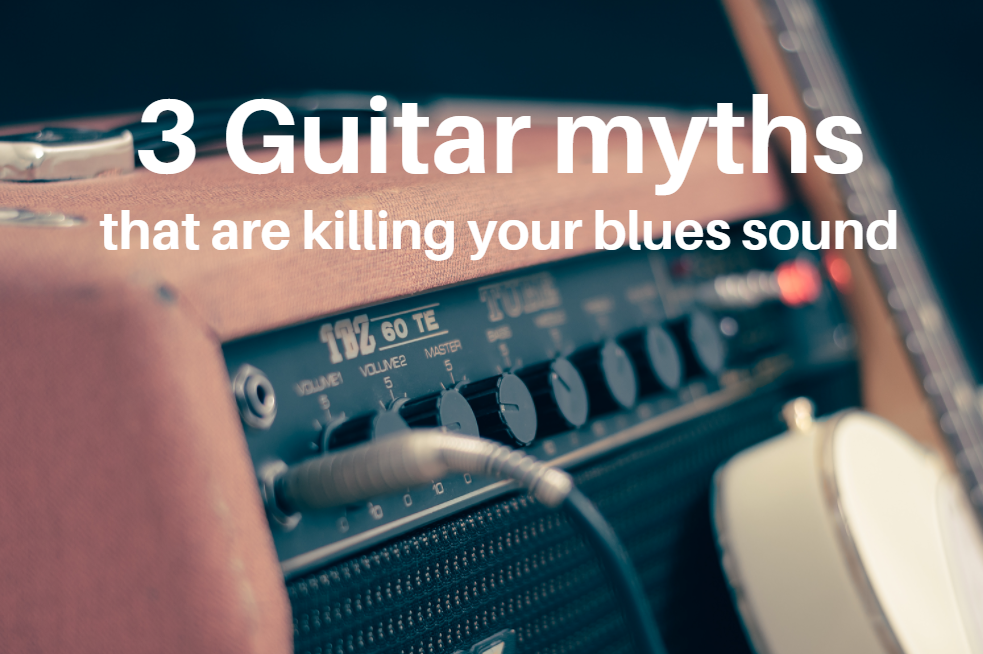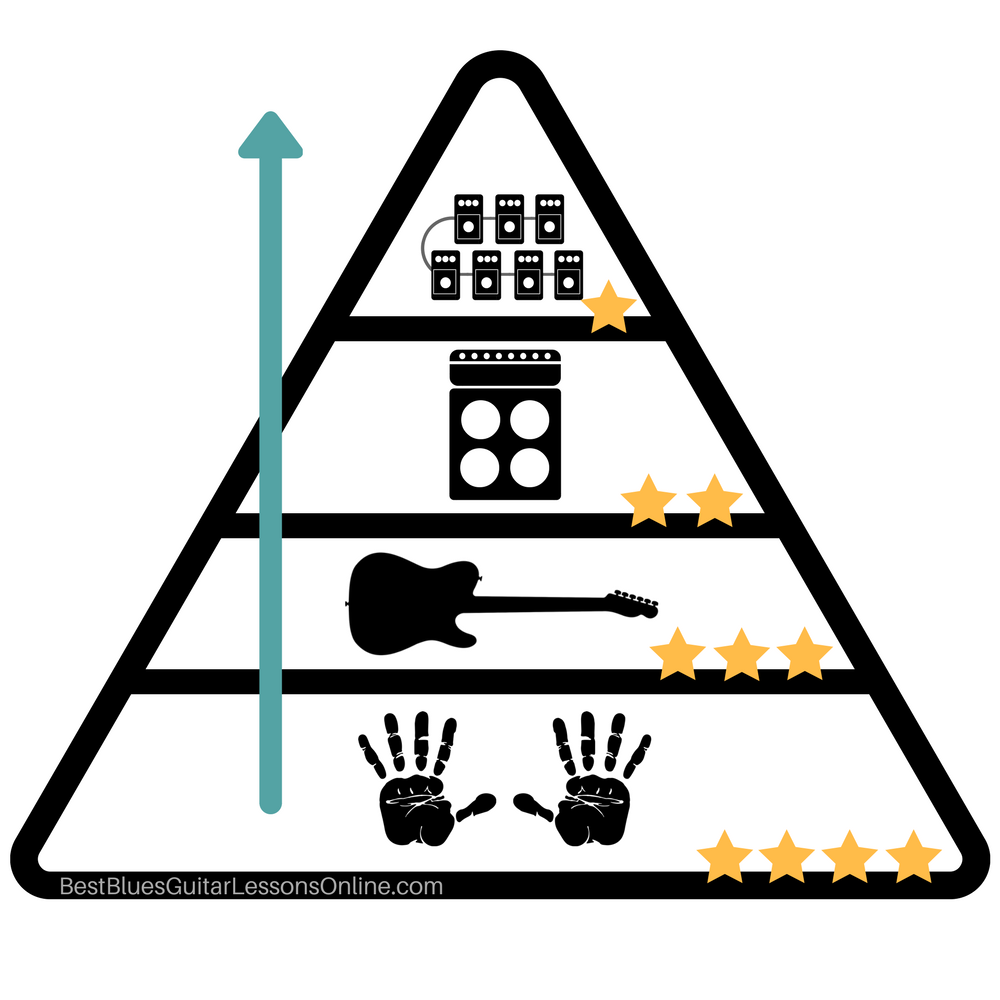3 Guitar Myths Slowing You Down From Getting A Great Blues Guitar Sound
How To Get A Good Blues Guitar Tone And Become An Original Sounding Blues Guitarist
By Antony Reynaert

Looking back, it used to be such a struggle to find a blues guitar sound that worked for me. Following advice blindly can be very frustrating, demotivating and confusing when nothing is working for you. A lot of these bad recommendations will only slow you down in the search of your own guitar sound.
Understanding Essential Concepts Such As Tone And Sustain Is Key
Hearing people talking about the ‘tone’ or ‘sound’ of their guitar can be very vague if you don’t have the correct knowledge or experience with the more technical side of the guitar. The tone of the guitar can basically be described as the color or quality of your sound. The time the sound last after you’ve strummed the guitar string(s) is called ‘sustain’ and depends on the overall construction of the guitar.
The Biggest Guitar Myths That Are Killing Your Blues Guitar Sound
The next three guitar myths slowed me down enormously to find a workable blues guitar sound that fits me as a guitarist. I also notice that there are still too many guitarists holding on to these ideas at expense of their own progress so make sure you aren’t one of them.

Guitar myth: One amp-setting to rule them all
Advice: Adjust the amp to the room and direct the amp to your ears
There is no such thing as a perfect amp-setting. Every room or stage has its own dimensions and atmosphere and asks for a slightly different setting. You need to learn to take full control over your amp-setting to adjust quickly to a new room.
~
Everyone starts off playing at home in a certain room with an amp-setting you like. After getting ready to start jamming with other blues guitarists, you’ll have to play at other locations too. When you go to a rehearsal or jam session you can’t just set the amp exactly the same way as you did at home and think your job is done. Your sound changes from room to room and the amp-setting needs to be adjusted every time in order to let your sound fit the room.
Another thing you need to keep in mind when setting up your amp in a room is that you always want to put the amp off the ground. Use a chair or a stand to tilt it in order to point the amp to your ear. A lot of guitar players still make the mistake of placing their amp behind them on the ground. This way the sound will pass under them and you don’t get the tone in your ears. Another disadvantage is that you won’t know how loud your amp really is. Jamming and rehearsing with the amp on the floor result in an obnoxiously loud guitar sound while the guitar player can’t really hear himself playing.
Lastly, you can’t make the mistake of following people's advice blindly. Don’t pay attention to someone telling you to always turn down ‘mid’, or in other words the knob controlling the mid-range and treble frequencies, from your amp. Especially if they haven’t heard you playing. Every combination of guitar and amp is different. There is no surefire amp-setting that always works for everybody.

Guitar myth: Your sound is all in the gear
Advice: Sound starts from the fingers
Your sound is not just defined by what amp you use and what guitar you play so don’t be misled by models and brands. Often times I hear people say “I bought the same guitar model and amp as Gary Moore uses. Why don’t I sound like him?”.
~
Sound is mostly defined by the way you play, certain techniques you use and playing habits you’ve acquired. Also, guitar players who perform on a high level often don’t just play on a stock brand guitar. The instrument is often altered to the preferences of the guitarist and so does the amplifier. The first thing in creating cool sounds is to become a very good blues guitarist in general.
Still there are things you can do to ensure a better tone out of your gear without the cost of buying new and ‘better’ equipment. People seem to think that if they buy ‘the best thing’ on the market they will also have the best sound. First of all you want to preserve your setup. Play on a clean fretboard with proper strings. Also, make sure your cables and connections are working optimally without being distorted so make sure you check them regularly. Old looking pedals work just fine as long as the inside electronics still deliver the sound as they are designed for so make sure you keep an eye on your pedals too.
Lastly you need experience to use gear in your advantage. Start with as little pedals and effects as possible when shaping your sound and gradually build up so you learn about the right order of pedals to get the best tones, the perfect amp-setting for your rig and how to control the tone knobs on your guitar with the setting you’re using.

Guitar myth: You need fat strings and a small pick
Advice: You chose the right pick and strings based on your own playing
There isn’t one perfect combination for guitar strings and a guitar pick in general to have. You have to consciously experiment and make your decision by checking the results. Just because using heavy gauge strings worked for Stevie Ray Vaughan doesn’t mean it has to work for you. Sure, it contributed to his guitar sound but it doesn’t mean that is the only way to get a fat sound.
~
For a long time I felt the need and pressure to use the same pick as a guitar player I looked up to. It’s a waste of time to keep trying when it just don’t feel comfortable for you. Keep in mind to try out other kinds of picks and strings. Not using the same strings and pick as the guitar player you look up to is anything but giving up your dream in seeking after that certain sound. Strings and picks come in all sorts of materials, sizes and shapes and they do have an impact on your basic blues guitar sound.
|
Guitar picks |
Guitar strings |
|
When looking at the pick itself, the thickness is the main factor on how it will affect your blues sound on guitar, but you can also take a look at other factors for example the shape, the material, the size and the edge type.
As a thumb rule, to gain more control for lead blues guitar you use a fatter pick. A smaller pick is more beneficial for strumming.
|
The guitar gauge, in other words the diameter of the guitar string is the main factor on how it will affect your blues guitar sound. Other factors that also will affect your guitar sound are the winding method, the coating and the used materials.
As a general rule, thin strings are easier to bend but give a skinnier sound. Fat strings on the other hand fatten up your sound. |
The most important part is that you align your own style with the guitar strings and pick you play. Choose the right pick and strings by acknowledging your own blues guitar playing: How deep are you letting your pick enter between the guitar strings? At what angle do you hit the strings with your pick? How tight do you hold the guitar pick? How fast do you play the guitar? Do you use a lot vibrato and string bending techniques? Etc.
Experimenting provides the only answer if you are wondering and doubting about what strings and pick to use. This may sound very obvious but a lot can be missed by not listening. Make sure you continue the experiment for a few weeks at least so you can adjust and make the right choice. One last crucial piece of advice is to record yourself while playing with different strings and picks to hear the difference and to finalize the experiment so you can make up your mind.
Work Your Way Up From The Basics And Develop An Awesome Guitar Sound
 There are many things to be said about electronics and effects but don’t forget about your basic guitar sound. The guitar sound always starts with the way you play the instrument. Gear is always second place. Out of all gear, it’s the instrument itself that that has the biggest influence on your sound. If you don’t like the instrument itself then don’t go investing on amplification, pickups and effects. Pay attention to the tone and sustain of the instrument without amplification. Even with an electric solid body guitar this is audible. Use the controls knobs and volume knob you have on your guitar to create unique blues sounds. Also use your pickup selector to really vary your guitar sound and create dynamics.
There are many things to be said about electronics and effects but don’t forget about your basic guitar sound. The guitar sound always starts with the way you play the instrument. Gear is always second place. Out of all gear, it’s the instrument itself that that has the biggest influence on your sound. If you don’t like the instrument itself then don’t go investing on amplification, pickups and effects. Pay attention to the tone and sustain of the instrument without amplification. Even with an electric solid body guitar this is audible. Use the controls knobs and volume knob you have on your guitar to create unique blues sounds. Also use your pickup selector to really vary your guitar sound and create dynamics.
The overall idea is that there is no real magic trick that will suddenly make you sound great. Working on your blues guitar sound is a quest. The only way to progress is by investing your time and attention to find the desired effect. In fact, the search is never ending but is on the other hand really wonderful. It is exciting and enriching to take the journey by experimenting and learning about different guitar sounds. Not paying any attention to sound will ruin everything you’ve practiced so you need to go on this journey to become a blues player people look up to.
As it is said: ‘sound starts from the fingers’ and you won’t deliver beautiful music when you haven’t learned blues guitar in a correct way. Take control over your sound by investing in a good solid base of blues guitar playing skills. In my free blues rhythm ebook you will learn how you can develop your guitar playing skills just like the blues masters.
Take your blues soloing skills to the top of the league with my Essential Blues Soloing Strategy and break out of the box.
